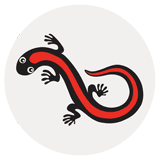Cordyceps: Destruction from the Inside Out
August 2, 2016 | Nora Boileau Morrison
Did you know that here in Clayoquot Sound we have a species of fungus that grows out of the eyes of the june beetle larvae? The fungus entirely takes over its host – just imagine waking up with fungal stalks growing out of your back, your head, and your eye sockets!
Cordyceps are a very diverse genus of fungi that attack insects and other arthropods. The fungus will replace the host’s tissue with its own fungal mycelium. The host supports the growth of the fungus to its mushroom stage. Once large enough, the fungus ejects its fruiting body out of the body of the host and then releases its spores to infect further victims.
Thousands of species of Cordyceps exist on earth, each parasitizing a specific host from the inside out. Some Cordyceps have been used in medications for humans, but luckily we have never been parasitized by them!
One bug-killing fungus, Cordyceps militaris, usually effects butterfly and moth pupas and larvae. The fruiting bodies of these fungi have recently been explored in various modern medicine practices, including cancer prevention.
The zombie fungus (Ophiocordyceps unilateralis) alters the behaviour of its tropical ant hosts. These Cordyceps manipulate the ant to stay stationary on a leaf by attaching themselves with their mandibles, patiently waiting to be taken over by the Cordyceps. In three weeks, the fruiting body of the fungus erupts from the ant’s head and produces spores. These Cordyceps can wipe out entire colonies of ants with this brain infestation.
The caterpillar fungus (Ophiocordyceps sinensis) infects Asian caterpillars and ultimately dries out their carcases. Once these Cordyceps have done their work on a caterpillar, the remains are widely sought after for treating asthma, impotence, and cancer. These caterpillar carcases can be collected by Tibetan nomads for the two week long harvesting period that follows the fungal bloom. Half a kilogram can be sold in China for up to 50,000 USD!
One type of Cordyceps, the drumstick truffleclub (Elaphocordyceps capitate), has been seen to parasitize another type of fungi! This fungus will parasitize deer truffles, and has been found here in Tofino.
Locally, what mycologists suspect to be june-beetle fungus (Cordyceps ravenelii) has been found in the sand dunes around Clayoquot Sound. This fungus was first recorded in 2001 in the Vargas Island dunes. These Cordyceps are found living off of ten-lined june beetle larvae (Polyphylla decemlineata), which live in the roots of introduced beach grass and have a life cycle of three years, making the parasitic fungi rare to spot. The fungus extends out of the larvae’s body through its eye sockets. Once large enough, the fruiting bodies emerge from the grass roots and become visible above the sand, closely resembling a common stick. The dark brown fungi are generally 2-10cm long and about 0.5cm-1cm wide. Since 2001, C. ravenelii have been found in the dunes of Schooner Cove, Radar Hill, the San Juan Islands, and most recently, Wickaninnish beach. Following the three year cycle of these fungi, there have been sightings here on the coast this spring, so look out for them!



